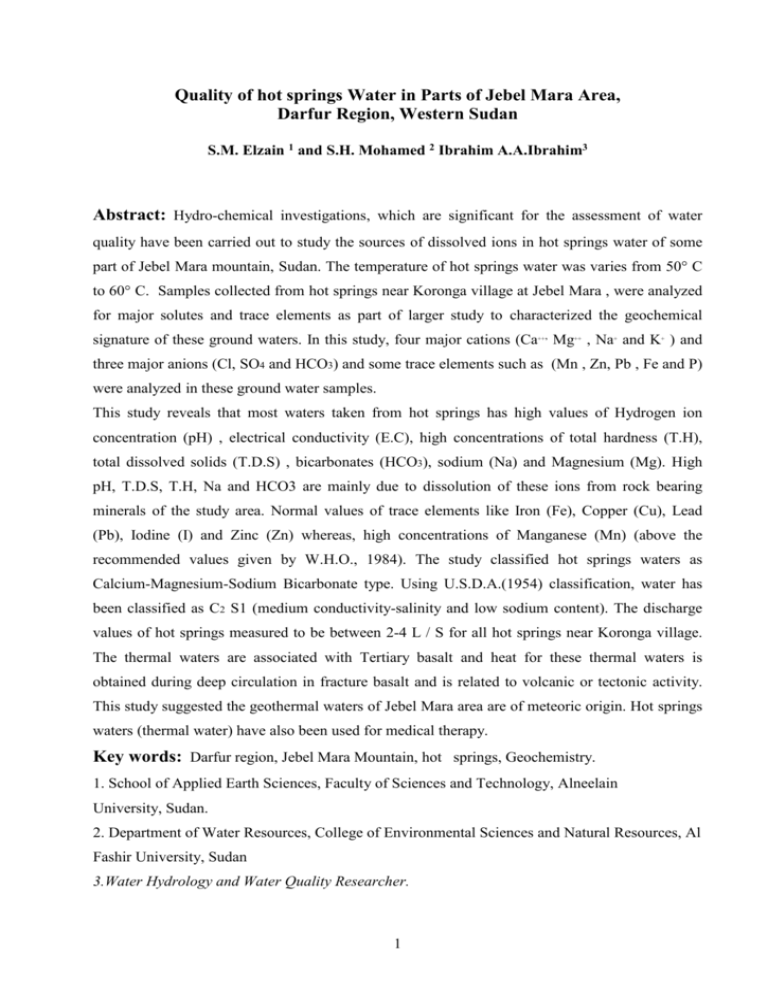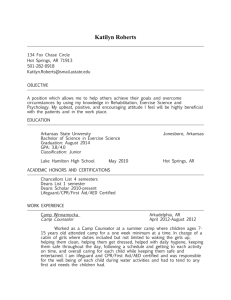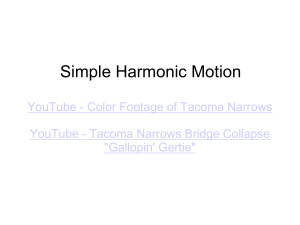Geochemistry of Hot Springs Water in Parts of
advertisement

Quality of hot springs Water in Parts of Jebel Mara Area, Darfur Region, Western Sudan S.M. Elzain 1 and S.H. Mohamed 2 Ibrahim A.A.Ibrahim3 Abstract: Hydro-chemical investigations, which are significant for the assessment of water quality have been carried out to study the sources of dissolved ions in hot springs water of some part of Jebel Mara mountain, Sudan. The temperature of hot springs water was varies from 50° C to 60° C. Samples collected from hot springs near Koronga village at Jebel Mara , were analyzed for major solutes and trace elements as part of larger study to characterized the geochemical signature of these ground waters. In this study, four major cations (Ca++, Mg++ , Na+ and K+ ) and three major anions (Cl, SO4 and HCO3) and some trace elements such as (Mn , Zn, Pb , Fe and P) were analyzed in these ground water samples. This study reveals that most waters taken from hot springs has high values of Hydrogen ion concentration (pH) , electrical conductivity (E.C), high concentrations of total hardness (T.H), total dissolved solids (T.D.S) , bicarbonates (HCO3), sodium (Na) and Magnesium (Mg). High pH, T.D.S, T.H, Na and HCO3 are mainly due to dissolution of these ions from rock bearing minerals of the study area. Normal values of trace elements like Iron (Fe), Copper (Cu), Lead (Pb), Iodine (I) and Zinc (Zn) whereas, high concentrations of Manganese (Mn) (above the recommended values given by W.H.O., 1984). The study classified hot springs waters as Calcium-Magnesium-Sodium Bicarbonate type. Using U.S.D.A.(1954) classification, water has been classified as C2 S1 (medium conductivity-salinity and low sodium content). The discharge values of hot springs measured to be between 2-4 L / S for all hot springs near Koronga village. The thermal waters are associated with Tertiary basalt and heat for these thermal waters is obtained during deep circulation in fracture basalt and is related to volcanic or tectonic activity. This study suggested the geothermal waters of Jebel Mara area are of meteoric origin. Hot springs waters (thermal water) have also been used for medical therapy. Key words: Darfur region, Jebel Mara Mountain, hot springs, Geochemistry. 1. School of Applied Earth Sciences, Faculty of Sciences and Technology, Alneelain University, Sudan. 2. Department of Water Resources, College of Environmental Sciences and Natural Resources, Al Fashir University, Sudan 3.Water Hydrology and Water Quality Researcher. 1 1. Introduction Jebel Mara volcanic complex situated in the western and southern Darfur state, with highest part situated some 80 miles from El Fashir town. The complex appears to have been formed during Tertiary but explosive and intrusive activity probably extended into Pleistocene and seen into recent. The predominant rocks are basalt, but trachyte and phonolite are said to be common locally. Pyroclastic rocks occur near the crater, and the Jebel Mara itself is describe as massive crater 5 Km. in diameter with two crater lakes, one saline (natron), the other fairly fresh, surrounded by walls of ash and tuff, pumice occurs locally. A number of hot springs were observed throughout the area especially near the crater. Springs occur where water from an underground aquifer flows out of the ground to the surface. The springs can occur where the water flows out of the ground by gravity, or it could be an artesian springs where the water appears at the surface under pressure from a confined aquifer below. The point at which water reaches the ground surface is known as the 'eye of the spring'. In the study area, some springs flows all he year around and some springs only flow forpart of the year. In apparent contrast to the arid climate, there are many discharge springs in the western part of Dariba crater, in Jebel Mara Mountains. These springs contains an unusually high concentration of Sulphur vapor, high discharge and high dissolved material which lead to high content of anions and cations, the on goining research shows that in the ten springs watershed, the springs also contribute significantly to the hydrologic budget of the system (Unpublished data).Ground water issuing from hot springs in ash basalt, are believe to consist of local recharge from Dariba Crater (Cater lake). More than 2 Km. to the south east.. Water from Dariba Crater believes to come in interbasin flow to reach the hot springs through fissures and cracks connected to each other. Bathing in natural thermal waters is very popular in Jebel Mara area. Thermal waters have also been used for medical therapy. 2 2. Materials and methods 2.1 Area of Study The Marrah Mountains (Jebel Marra, Arabic) is a range of volcanic peaks created by a massif that rises up to 3,000 m. It is located in the center of the Darfur region of Sudan. The highest point is Deriba Crater (two lakes are there the largest and the smallest). The upper reaches of the massif is a small area of temperate climate with high rainfall and permanent springs of water. The last eruption occurred around 2000 BC. The area under consideration located in arid to a semi arid climate between 24° -25° E and latitude 13° 03 N. Ten hot springs located their .The are characterized by two main season; ( a) Dry season started approximately from Nov. to May, and (b) rainy season from June to Oct. The climate in semi arid condition varies from region to region and from season to season. During the Manson, the average rainfall varies from about 900 mm. in the western districts to more than 1100 mm. at the upper zone (hilly area). The average temperature varies from 15° C (during January) to 40° C (during May). The natural lake (Dariba Crater) located just 1.5 to 2 Km. southwest of the hot springs. About ten warm springs were recorded on Jebel Idwa, a subsidiary cone about 2 Km. far from Dariba Crater. Some hot springs and fumaroles along the northwest margin of the inner Dariba Crater lake were recorded, the other hot springs were situated Near Koronga Village .The temperature of hot springs ranging from 55° to more than 60° C. 2.2. Lab Works Water samples were collected from ten hot springs near Koronga village, about 2 Km. away from Dariba Crater during May 2002. All samples were analyzed at Al Neelain University laboratory, School of Applied Earth Sciences & Technology and Vet. Research lab, Soba Khartoum. for major ion chemistry, using standard methods for examination of water and waste water, American Public Health Association (A.P.H.A.), 1984), American Water Works Association (A.W.W.W., 1984), and Water Control Federation (1985), standard classical methods (Jackson,1958),Trivedy and Goel,1984), were also used. Hydrogen ion concentration (pH) and specific electrical conductivity (S.E.C.) were measured using pH and E.C meters respectively. Total dissolved solids (T.D.S) were computed by multiplying the SEC by the factor (0.65), Bicarbonate (HCO3) were estimated by titrating the samples with HCL, total hardness 3 (T.H) as CaCO3 were analyzed tetrimetrically using standard E.D.T.A., Magnesium (Mg++) was calculated from the total hardness. Calcium (Ca++), Sodium (Na+) and Potassium (K+) were measured using flame photometer. Chloride (Cl) was estimated tetrimeterically using standard AgNo3 solution, Sulphate (SO4) by gravimetric method using Barium chloride to precipitate the salt. Mn, Zn, Fe, Cu, Pb and P were measured using Atomic Absorption Device (A.A.S..229 UNICAM) All parameters are expressed in milligram per liter (mg/l) except E.C (expressed in Ms/ cm.).The analyzed precession for the measurement of cations (Ca, Mg, Na and K), anions (HCO3, Cl and SO4) is indicated by the ionic balance error, which is observed to be within the stipulated limit of ± 5%. However, temperatures, pH, E.C were first measured in the field at the time of taking samples. 4 5 3. Results and Discussions The results of all physical and chemical analysis of hot springs water are presented in Table No. 1. A number of springs were observed during the field trip to the area. Ten springs 2 Km. away from Koronga village were hot (their temperature about 50° C to 60° C). The pH values of hot springs waters showed that all values has a high values and in ranges from 9.00 to 9.7 (Fig. 1). The highest values indicating the presence of carbon dioxide, carbonate and bicarbonate in water. These highest values indicating an alkaline nature. The desirable limit of pH values for drinking water has been given by the World Health Organization (W.H.O, 1984) is varying from 7 to 8.5, while the maximum permissible lit level is 9.2. The concentration of T.D.S. in hot springs was varying from 365 to 1150 mg/l, (Fig. 2). Generally all samples show higher concentrations. All T.D.S values were more than 500 mg/ l). The upper limit give by W.H.O, 1984 is 1000 mg/l. Electrical conductivity (E.C) in water from hot springs were vary from 24 µ /cm (spring No.3) to 746 µ /cm, (Fig. 3). 6 Samples analysis for total hardness (T.H) has been classified as medium hard water except samples No.7 classified as hard water, (Fig.4). The standards of hardness for drinking water supply vary; viz, The World Health Organization 91984) suggested an upper limit 500 mg/l of CaCO3.The American Water Works Association has prescribe an upper limit of 80 mg/l of CaCO3for ideal water (Hem, 1989 and BBS Sinbal &R.P. Gupta, 1999). Sodium considered harmful to persons suffering from Cardiac disease and high blood pressure. Therefore, the concentration of sodium should be within the limit recommended by W.H.O., (1984) as 200 mg/l for drinking water. About 60% of the samples were taken from springs has higher concentration (more than 60 mg/l) where as 40% of the samples showed concentration less than 50 mg/l (Fig. 5). Regarding the samples analysis for Potassium (K+) springs No. 1,4,5,8 and 9 has high values (Fig..6). The concentration of Calcium varies from 24 to 95 mg/l Fig. 6. No harmful effect from calcium. From Fig. 6, springs No. 1, 4, and 9 shows higher concentrations of calcium; above 68 mg/l .All values of calcium in hot springs were normal and fall within the permissible limit given by W.H.O, (1984). According to E.E.C. (European Economic Community) the recommended value up to 50 mg/l, where as the I.S.I. (Indian Standard Institution) the recommended value is 30 mg/l. No recommended value given by W.H.O. regarding this ion. The high values of magnesium from all hot springs waters have been examined (Fig. 7). This is mainly due to presence of olivine, pyroxene and rocks covering the whole study area. Among the cations, the concentrations of Ca2+ , Mg2+ , Na+ and K+ ions ranged from 24 to 95 , 15 to 80, 10 to 75 ,5 to 35 mg/l with mean of 53.7 , 44, 43. 6, 16. 9 mg/l respectively. Their ionic concentration (on the basis of epm / l (meq / l) were ……,…….,……,……The order of a balance is Ca>Mg> Na >K. Regarding the dissolved anions , Chloride concentration were vary from 30 to 46 Fig. 8 Chlorides concentrations in hot springs are restricted in range (less than 55 mg/l). Sulphate concentrations were vary from 10 to 40 mg/l, Fig. 9 (les than 75 mg/l). All samples analyses for 7 Sulphate fall within the permissible limit./l with a mean of 428,5,37,5,26,2 and mg/l respectively . The order of their bundance (epm %) is HCO3 >Cl > SO4. 4. Conclusions All Samples taken from hot springs has its temperature ranged between 55°-60° C, higher pH values which consider alkaline in range (9.00−9.66), high T.D.S. (365−1150 mg/l), rich in sodium (10−75 mg/l), rich in bicarbonate (215−800 mg/l) and higher total hardness . Chlorides concentrations in hot springs are restricted in range (less than 55 mg/l). Sulphate concentrations were les than 75 mg/l. All samples analyses for sulphate fall within the permissible limit. ِalkalinities concentrations ranges from moderates to high values (from 215 to 800 mg/l. It appears that alkalinity decreases toward direction. Water taken from hot spring classified as Calcium -Sodium –Bicarbonate Chloride type. In the study area, thermal water associated with Tertiary rocks. Heat for thermal waters comes from volcanic, tectonic activity and deep water circulation in the fracture rocks. All Samples from hot springs classified as C1S1and C1S2. All geothermal waters in Jebel Mara Mountain are closely associated to joints and fractures of Tertiary basalt. Natural disasters such as earthquakes, volcanic eruption, drought, landslides can affect springs. 5. Recommendations 1. Protect the catchments area around and above the hot springs from animals and humans to prevent contamination. 2. The area around the springs should be fenced to prevent accesses by animals 3. No latrines should be located within 20 am upstream or downstream of springs. 3. Further geological surveys should be carried out together with subsequent chemical analysis 4. Paved roads from different part of Sudan to Jebel Marra area should be constructed. References 1. American Public Health Association, (1975). Standard Methods for the Examination of Water – Waste Water, 14th edit., A.P.H.A., A.W.W.A., and W.P.C.F., Washington D.C. 8 2. American Public Health Association, (1984). Standard Methods for the Examination of Water – Waste Water, 17th edit., A.P.H.A., A.W.W.A., and W.P.C.F., Washington D.C. 3. Alzain S.M., (1992).Genesis of Red Beds from Khanapur Plateau, Ph. D Thesis, University of Pune, Mahrashtra India. 4. -Hale G.A., (1967).Cultivation Terraces in Weast Darfur, Sudan. A case study in an Agricultural form and Practice, PhD Thesis, University of Khartoum. 5. Hem J.D., (1971) Study and interpretation of the Chemical Characteristics of Natural Water, 2nd ed., U.S.A. Geological Survey, Water Supply, United States Geo. Survey, Water Supply. 6. Hem J.D., (1959) Study and interpretation of the Chemical Characteristics of Natural Water, 2 nd ed., U.S.A. Geological Survey, Water Supply, United States Geo. Survey, and Water Supply. 7. Mohamed A.K., (2001). Management of Bosweella papyrifera stands for Resin Production in Jebel Mara area, Western Sudan. M. Sc. thesis of Deroson, Germany. 8. Todd D.K., (1980). Ground water Hydrology 2 nd edit John Wiley &Sons, N.Y, 535 p. 9. Uli U. and Siegfried U.,(1998). Water Discharge of the Galol River in the Jebel Mara Mountains, Sudan. Int Journal of Environment and Pollution Vol. 9, 443 p. 10. W.H.O., (1984) Guidelines for Drinking Water, Water Quality, Vol.1, 2, 3, Health criteria and other supporting information, Geneva. 11. W.H.O.,(1995) Guidelines for Drinking Water, Water Quality,2nd edit ,Vol.1, W.H.O., Eastern Mediterranean Regional office, Geneva. Health Criteria and other Supporting Information, Geneva. 12. A.P.H.A, (1992).Standard methods for the Examination of Water and Waste Water. American Public Health Association, Washington D.C. 9 Table (1) Results of physical and chemical analyses of water samples from ten hot springs Sample No. pH E.C µS/cm T.D.S mg/l T.H mg/l Na mg/l K mg/l Ca mg/l Mg mg/l Cl mg/l 1 9.7 746 1150 175 75 35 95 80 35 25 800 2 9.59 290 445 60 30 10 25 35 30 10 300 3 9.27 240 365 65 10 5 50 15 35 30 215 4 9.49 606 930 130 70 25 85 45 46 25 630 5 9.65 488 750 100 45 20 35 65 35 40 500 6 9.66 455 700 115 60 15 70 45 45 25 420 7 9.5 288 440 57 32 11 24 33 32 12 295 8 9 475 730 135 44 19 33 62 36 39 490 9 9.5 436 668 111 58 16 68 42 43 23 410 10 9.2 256 494 72 12 8 52 18 38 33 225 Table (2) 10 SO4 mg/l HCO3 mg/l Results of Trace elements analyses of water samples from ten hot springs Sample No. Mn Zn Fe I Cu Pb 1 1.62 .61 .45 .31 .146 .06 2 1.65 .19 .51 .23 .086 .002 3 1.66 .19 .5 .83 .041 .004 4 1.68 .21 .49 .22 .83 .003 5 1,68 .21 .47 .26 .059 .005 6 1.99 .22 .51 .25 .09 .003 7 1.62 .21 .64 .21 .035 .006 8 1.7 .32 .54 .3 .63 .006 9 1.8 .31 .42 .36 .082 .003 10 1.65 .61 .51 .92 .09 .004 11 Table (3) The discharge values of ten hot springs Spring No. Discharge values in (L/S) 1 6 2 6 3 6 4 6 5 5 6 5 7 4 8 4 9 4 10 4 12 13 14







